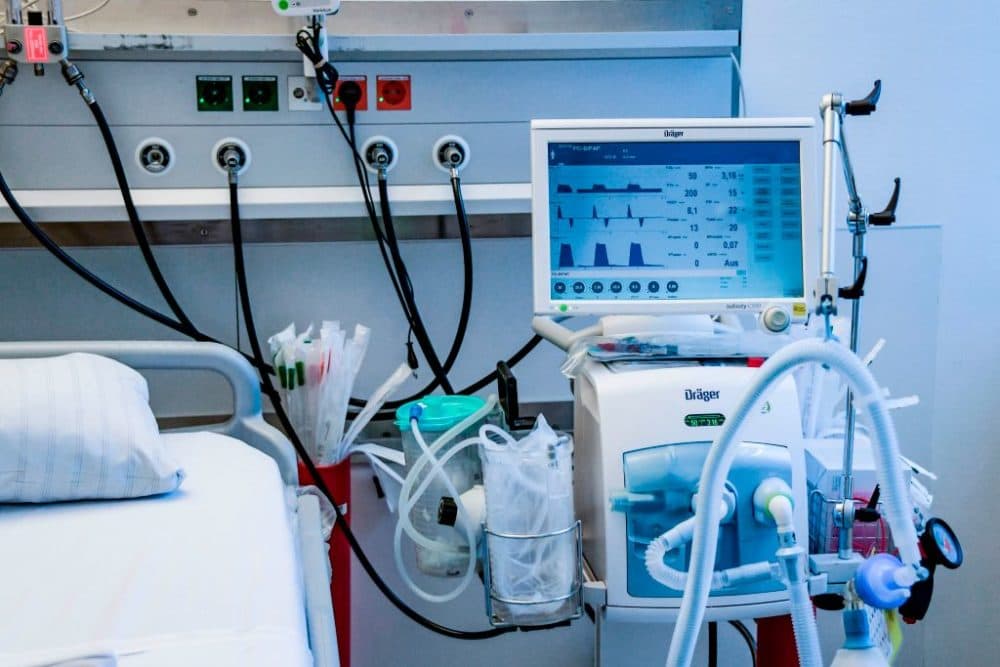Advertisement
Coronavirus Coverage
How Intubation Went From A Common Hospital Procedure To A Critical Function In Addressing COVID-19

In normal times, two or three patients a day would need to be intubated at Beth Israel Deaconess Medical Center.
These are not normal times.
"On any given day, we would intubate approximately 10 patients that had COVID-19," says Dr. Daniel Talmor, who oversees anesthesia and critical care at Beth Israel Deaconess, including more than 80 COVID-19 patients in intensive care, most on ventilators.
Talmor says the staff generally tries first to sustain patients with extra oxygen they can breathe through their noses, and they lay the patients on their bellies, which can help with oxygen absorption.
"But when we start to see the patient struggle, to breathe rapidly, to breathe deeply, that's when the patients start to injure their own lungs with breathing," he says. "And at that point, we intubate, and we don't let them stay a long time struggling like that, because we think that the effort actually injures your lungs."
The intubation process involves inserting a plastic tube nearly a foot long down the patient’s windpipe — an up-close and therefore risky maneuver.
"There is a high likelihood of viral load being sprayed in close proximity to the physician doing the intubation," Talmor says. "That’s one of the reasons why anesthesiologists in particular seem to be at high risk for getting COVID-19 from their patients."
So the doctors are swathed in protective gear, including N95 masks. So far, Talmor says no Beth Israel Deaconess anesthesiologists have caught the virus from intubations.
"And we do the intubation in such a way that the patients aren't breathing spontaneously and won't cough on you, by paralyzing the patients while we're intubating them, with a drug." he says.
Once on the ventilator, COVID-19 patients often stay on for long stints — eight or nine days, or more. "And we've seen patients — and we still have patients — who have been two or three weeks on the ventilator," Talmor says. "And that's unusual. That is longer than we typically see."
Advertisement
Ventilators can save lives, but far from always. Studies in China, Europe and the US find that more than half of COVID-19 patients on ventilators don’t make it. Talmor says whether the machines are actually being overemphasized and overused is a rising question in COVID-19 care, "and one that is hotly debated online between critical care physicians."
Doctors around the world are still learning more about the medical specifics of COVID-19, he says. One peculiarity is that very ill patients often have prolonged failure of just the lungs rather than of multiple organs. Another is that the lungs don’t tend to become inflamed and filled with fluid as they typically do in a familiar form of lung failure called acute respiratory distress syndrome.
"This is really a new type of lung injury that we haven't seen much before," he says.
Boston-area patients are lucky to have access to a city that is packed with medical expertise and constantly gaining more as critical care experts collaborate around the world to share COVID-19 lessons, he says.
"And we're getting better," he adds. "We're seeing better results here than have been seen in other places. And that's because we've had time to learn from others."
And he emphasizes that a fair number of COVID-19 patients do get better enough to have the tube removed — to be extubated. And it’s early days yet, with many patients having arrived in the ICUs only in the past few days.
"Of the patients with COVID in our ICUs, I would say that, roughly, we’ve extubated 25%," Talmor says.
In the busy intensive care unit hallways at Beth Israel Deaconess Medical Center these days, staffers ring a bell and cheer when a patient is liberated from the ventilator. Celebrating extubations is a COVID-era tradition that seems to be spreading quickly on social media: some hospitals play extubation music — uplifting tunes like the theme from "Rocky" — and some staffers have even developed extubation dances.
"I tell people, you know, this is a war and the ICU is the battlefield," Talmor says. "So those are the victories."
This article was originally published on April 16, 2020.
This segment aired on April 16, 2020.
